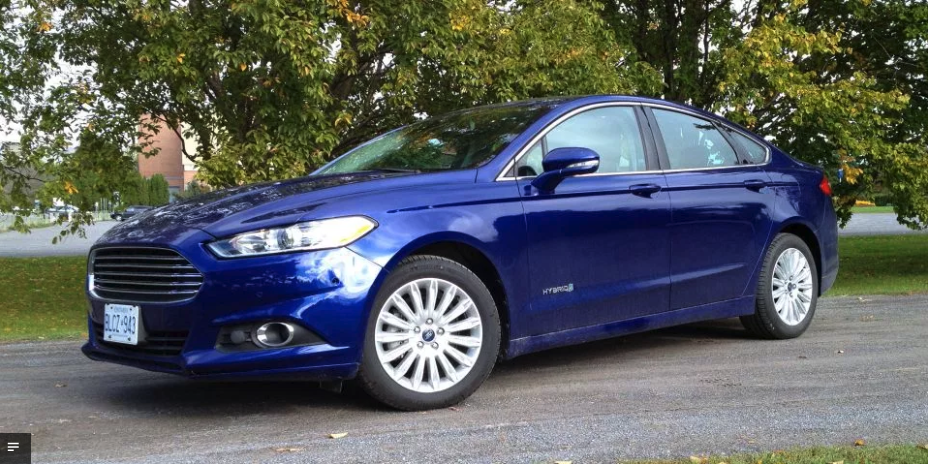Road Test: 2014 Ford Fusion Hybrid SE

Story and photo by John LeBlanc
You can’t get any more “mainstream” than the Ford Fusion sedan. The sedan’s conservative, four-door-with-a-trunk body style is the type of vehicle that’s been around almost as long as the Ford Motor Co. itself. But underneath this particular gasoline-electric hybrid version of Ford’s best-selling family machine is anything but conventional.
To recap: The Fusion is Ford’s volley into the super-competitive, mid-size, five-passenger family sedan market, crammed with heavyweights like the Toyota Camry, Hyundai Sonata and Honda Accord. For its most recent redesign for 2013, the second-generation Fusion adopted a slinky-looking, Aston Martin-like exterior, sophisticated European-engineered road manners and a range of four-cylinder gas engines from 1.5 to 2.5 litres, front- or all-wheel-drive, a gasoline-electric Hybrid and the so-called Energi plug-in hybrid.
I’ll save my thoughts on the Fusion Energi plug-in hybrid electric vehicle for another day. But let’s go right to the biggest reason why car buyers would consider the Hybrid Fusion over its gas-only models: its exceptional fuel economy. According to our federal government assessors, the 2014 Fusion Hybrid’s 4.0 litres per 100 kilometres city and 4.1 highway estimates big improvements over the last-generation Fusion Hybrid’s respective 4.6 and 5.4 numbers. Those figures also beat the Ford’s chief rival: the Toyota Camry Hybrid, and its 4.5 L/100 km city and 4.9 highway numbers.
During my week with the 2014 Fusion Hybrid SE tester, my mileage did vary; scoring a more realistic 5.8 L/100 km in a mix of city and highway that leaned heavily in favour of urban driving. The Ford four-door manages to score such fuel economy via its Atkinson-cycle gas four, shrunk from 2.5 litres in the older Fusion Hybrid to just 2.0 now. It makes 141 horsepower, aided by an electric motor for a combined 188 pound-feet of torque rating. Power is transferred to the front wheels through an electronic continuously variable automatic transmission.
The Fusion Hybrid also benefits from the ongoing developments of what is admittedly an immature battery industry. A 1.5 kilowatts per hour lithium-ion battery pack replaces the older model’s nickel-metal-hydride batteries. The main advantages of the lithium-ion batteries are the size and weight reductions (down to 48 kilograms from 68) that now allow for fold-down rear seats.
At 9.2 seconds, the latest Fusion Hybrid takes about a half-second longer to go from zero to 100 kilometres per hour than the older Fusion Hybrid — or almost two seconds slower than the 200-hp Toyota Camry Hybrid. Still, most potential hybrid sedan owners don’t give a rip about acceleration time (the Lexus CT 200h, a “sports compact hybrid,” is a second slower than the Fusion Hybrid). And the Ford hybrid family sedan makes up the difference over the Toyota hybrid family sedan once you have the cars up to speed.
Eerily similar to its gas-only siblings, the Fusion Hybrid SE’s ride and handling characteristics are near the top of this full class — even when compared to non-hybrid rivals. The Fusion’s electric steering has some feel and is linear in use. And its MacPherson strut front and multi-link rear suspension deliver the type of firm yet controlled ride Audi drivers are used to. The Ford’s gradual transition between its gas and electric power would be the envy of BMW owners. A well-mated CVT means the Fusion Hybrid’s overall driving experience is one of refinement and — dare I say — luxury. The only blight in the Ford four-door’s driving is its soft-feeling brakes that are doing double duty stopping the car and recapturing energy to charge the battery pack.
There are only a few “Hybrid” badges on the Fusion’s exterior to differentiate it from the less fuel-efficient models. There are also only a few clues in its cockpit, mainly limited to the digital information screens bracketing the driver instrumentation. For example, the display to the right of the speedometer adds “leaves” the more efficient you drive. While the screen to the left displays dynamic engine and e-motor information. Other than that, the rest of the Fusion Hybrid’s cockpit remains as-is: simple, uncluttered and mildly annoying whenever you need to use the MyTouch voice-command system.
With fuel creeping around $1.50 per litre at the pumps, you can see how owning such a fuel-efficient family sedan like the Fusion makes a whole lot of sense. For $30,549 (all prices include freight and pre-delivery inspection fees), the Fusion Hybrid starts at the mid-line SE trim level, halfway between the base $23,549 Fusion S gas-2.5 and the topline $41,499 Fusion Energi Titanium PHEV. Not a bad price for a new “mainstream” family sedan with exceptional fuel economy.
WHAT I LIKED: Excellent fuel economy; sports sedan handling; non-white bread styling
WHAT I DIDN’T: A bit slow off the line; soft-feeling braking
Type of vehicle Mid-size, four-door sedan
Engine 2.0L DOHC four-cylinder + electric motor
Power 141 hp @ 6,000 rpm; 188 lb.-ft. of torque @ 4,000 rpm (combined)
Transmission Continuously variable automatic
Brakes Four-wheel disc with ABS
Tires P235/45R18 all-season
Price (base/as tested) $28,999/$31,259
Destination charge $1,550
Natural Resources Canada fuel economy (L/100 km) 4.0 city; 4.1 highway; 5.8 as-tested
Standard features Dual-zone air conditioning, cruise control, power windows, mirrors and door locks, remote keyless entry, keypad locking, tilt/telescopic steering wheel, auto-dimming rear-view mirror, power driver’s front seat, AM/FM/CD/MP3/Sirius audio system with six speakers, Sync communications and entertainment system, automatic headlights, speed-sensitive windshield wipers, stability control, traction control
Options $1,469 Luxury Package; $791 Technology Package





![[del.icio.us]](https://www.straight-six.com/wp-content/plugins/bookmarkify/delicious.png)
![[Digg]](https://www.straight-six.com/wp-content/plugins/bookmarkify/digg.png)
![[Facebook]](https://www.straight-six.com/wp-content/plugins/bookmarkify/facebook.png)
![[Google]](https://www.straight-six.com/wp-content/plugins/bookmarkify/google.png)
![[Reddit]](https://www.straight-six.com/wp-content/plugins/bookmarkify/reddit.png)
![[StumbleUpon]](https://www.straight-six.com/wp-content/plugins/bookmarkify/stumbleupon.png)
![[Twitter]](https://www.straight-six.com/wp-content/plugins/bookmarkify/twitter.png)
![[Email]](https://www.straight-six.com/wp-content/plugins/bookmarkify/email.png)